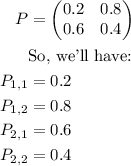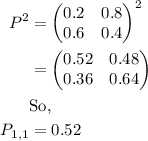
Mathematics, 21.11.2019 05:31 jocelynbeoletto
Amarkov chain has the transition matrix shown below: p =[0.20.8] 0.60.4 (1) if, on the first observation the system is in state 1, what is the probability that it is in state 1 on the next observation? (2) if, on the first observation the system is in state 1, what state is the system most likely to occupy on the next observation? (if there is more than one such state, which is the first one.) (3) if, on the first observation, the system is in state 1, what is the probability that the system is in state 1 on the third observation? (4) if, on the first observation the system is in state 1, what state is the system most likely to occupy on the third observation? (if there is more than one such state, which is the first one.)

Answers: 1


Other questions on the subject: Mathematics

Mathematics, 21.06.2019 17:30, decoreyjpaipxv
Miguel’s teacher asks him to color 4/8 of his grid. he must use 3 colors: red, blue, and green. there must be more green sections than red sections. how can miguel color all the sections of his grid to follow all the rules
Answers: 1

Mathematics, 22.06.2019 00:30, babycakesmani
Jo divides a candy bar into eight equal pieces for her children to share she gives three pieces to sam three pieces to leslie and two pieces to margie rose the two month old baby does it doesn't get any what fraction shows how muchw candy each of the four children got. what's the answer to my question
Answers: 2


Mathematics, 22.06.2019 01:10, aidanfbussiness
I'm marking the brainliest and it's 15 points
Answers: 1
You know the right answer?
Amarkov chain has the transition matrix shown below: p =[0.20.8] 0.60.4 (1) if, on the first observ...
Questions in other subjects:

Biology, 04.06.2021 14:00

Computers and Technology, 04.06.2021 14:00


Physics, 04.06.2021 14:00

Mathematics, 04.06.2021 14:00

Spanish, 04.06.2021 14:00

Mathematics, 04.06.2021 14:00


Mathematics, 04.06.2021 14:00

Physics, 04.06.2021 14:00







